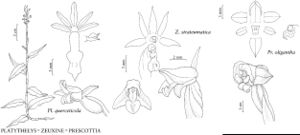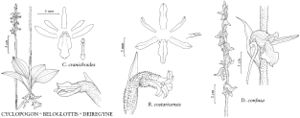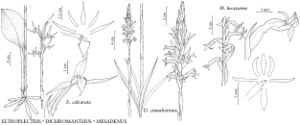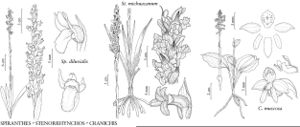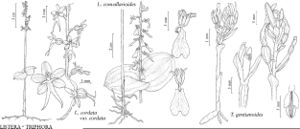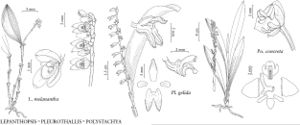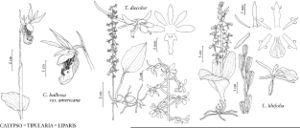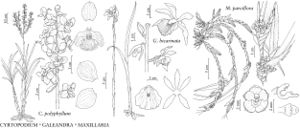Orchidaceae
Herbs or rarely vines, perennial, rarely annual, strongly mycotrophic, epiphytic, terrestrial, lithophytic, or rarely aquatic or subterranean, usually green and photosynthetic, some without chlorophyll and saprophytic. Roots subterranean or aerial, tuberoid or stolonoid, usually with spongy, multilayered velamen. Stems erect or pendent or modified into creeping rhizomes, simple or sympodially or monopodially branched, delicate to stout, or thickened as corms or pseudobulbs, or greatly reduced, sometimes proliferous (especially diverse in sympodial orchids). Leaves solitary, several, or reduced to scales, basal or cauline, alternate, distichous, or sometimes opposite or whorled, either convolute or duplicate, simple, sessile or petiolate; stipules absent; blade articulate or not, plicate or conduplicate, cylindric, triangular, or laterally flattened, margins entire. Inflorescences terminal or lateral, racemes, spikes, panicles, or rarely cymose, erect or variously pendent, 1–many-flowered, lax or dense, flowering successively or simultaneously. Flowers bisexual [rarely unisexual], epigynous, resupinate or not, pedicellate or sessile, 3-merous, usually bilaterally symmetric [rarely nearly radially symmetric], with abscission layer between pedicel and peduncle, rarely between ovary and perianth or ovary and pedicel; perianth of 6 tepals in 2 whorls, all petaloid or sepals sometimes greener and more foliaceous in texture; sepals alike or not, lateral sepals often connate (forming synsepal), or all 3 sepals variously connate and/or adnate or distinct and/or free; petals 3, median petal modified as lip, commonly larger or differing in form and color, lateral petals commonly but not always similar to sepals; nectaries of various sorts; extrafloral nectaries sometimes present on pedicels, bracts, or leaf-sheaths; stamens usually 1–2 (–3, if 3 the 3d modified into sterile staminode), all on side opposite lip, fully or partially adnate to style, forming column; pollen-grains in monads or tetrads, usually in 2–8 pollinia, sometimes subdivided into small packets, rarely granular, sometimes pollinia with caudicles and/or stipes; gynoecium 3-carpellate, connate, forming compound, inferior, 1-locular or 3-locular ovary; style variously adnate to filaments; stigmas usually 3-lobed, concave to convex, part of median stigma lobe modified into rostellum, often separating anther from fertile portions of stigma, commonly preventing or in some cases facilitating self-pollination; ovules numerous, anatropous, minute. Fruits capsules, opening (dehiscing) by longitudinal slits, rarely fleshy and indehiscent berries. Seeds numerous (millions in some species), minute; endosperm absent.
Distribution
Worldwide except Antarctica, most diverse in tropical forests
Discussion
Genera ca. 800, species 22,000–35,000 (701 genera, 208 species in the flora; 1 genus, 6 species introduced).
The overall count for orchid genera in the flora includes Spathoglottis plicata Blume, which was recently reported from Palm Beach County, Florida. The plants, known locally since 1982, are apparently widely naturalized in old shellpits. The number of species in the flora includes one newly recognized species in Habenaria that is morphologically described, but not fully treated here.
Orchidaceae are by far the largest and most diverse monocot family and rank among the largest families of flowering plants. An accurate account of the number of genera and species has eluded orchid scientists, and species counts published in the last 20 years range from 15,000 to 35,000. New species are continually being described. In addition, numerous natural and artificial hybrids exist.
Although orchids are important in horticulture, most of the plants traded in the national and international market belong to a small number of species and their hybrids in only a few genera; the majority of orchids are not commonly cultivated. Few orchids are economically important outside the horticultural trade: the fruits of several species of Vanilla are the source of the spice vanilla, and the dry roots of some species of Dactylorhiza, Eulophia, and Orchis are made into salep, a flour consumed in northern Africa, the Middle East (especially Turkey), and Asia. Some species are locally used for medicinal purposes; the mucilage from pseudobulbs of several species is sometimes used as glue; and in the Far East the stems of some species of Dendrobium are split into strips used to weave handicrafts. A few orchids have been found to cause contact dermatitis (e.g., Cypripedium reginae).
Orchids range vegetatively from Lilliputian plants a few millimeters long (Bulbophyllum Thouars and Platystele Schlechter) to gigantic clusters weighing several hundred kilograms (Grammatophyllum Blume) to some as much as 13.4 meters in height (Sobralia altissima D. E. Bennett & Christenson, a recently described species from Peru). Likewise, flowers vary in size from less than 1 mm and barely visible to the naked eye (Platystele Garay), to 15–20 cm diameter (some Paphiopedilum Pfitzer, Phragmipedium Rolfe, and Cattleya Lindley spp.), and ultimately to 76 cm [Phragmipedium caudatum (Lindley) Rolfe]. Weight can vary from a fraction of a gram (many Pleurothallus R. Brown spp.) to nearly 100 grams (Coryanthes Hooker spp.). Their fragrances vary from delightful (Cattleya Lindley) to repulsive and unbearable (in some species of Bulbophyllum Thouars). The plants colonize habitats ranging from some of the driest and hottest places on earth to the wettest and coolest, literally occurring from polar regions to the equator.
Within the monocots, the most important diagnostic features of Orchidaceae are reduction of adaxial stamens, fusion of the remaining stamens to the gynoecium forming the column, aggregation of pollen into compact pollinia (present elsewhere only in the dicots, in Asclepiadaceae), differentiation of the median petal into the lip, a sometimes complex organ, and the exceedingly small size of the seed, which lacks endosperm. Among other distinguishing characteristics: pollen in the pollinia is usually not available as a nutrient-source (Cleistes Richard ex Lindley being a notable exception), and the often complex interaction with pollinators culminates in the phenomenon of pseudocopulation in several genera (e.g., Ophrys Linnaeus, Caladenia R. Brown sect. Calonema, Drakaea Lindley). In the latter process, the flower mimics the appearance, the smell, and often the movements of a female wasp, attracting a male of a suitable species that tries to copulate with the flower. It usually only succeeds in becoming attached to a pollinium, which will then be transferred if the male tries to copulate with another flower.
Roots of orchids may be covered with velamen, spongy layers derived from the epidermis; fleshy thickenings of roots are tuberoids (tubers being restricted to stems). Stems may be swollen or thickened, underground corms or aerial pseudobulbs. Flowers are often resupinate: the lip (modified median petal) is “lowermost,” usually as a result of the pedicel being twisted or bent in its development by 180°. Pedicellate ovary, usually used in reference to length, refers to the combined pedicel and ovary. Flowers are not always borne on pedicels; when they are, it is sometimes difficult to distinguish between a slender ovary and the pedicel. Consequently, because of their slender ovaries, flowers of a “racemose spike” appear to be pedicellate even though they are sessile, while a “spicate raceme” has pedicels so short that they appear to be absent. Orchid flowers often have a modified median sepal, the dorsal sepal. Sepals coalescing at their tips form a synsepal. The middle portion of the upper (adaxial) face of the lip is the disc: it may be a thickened callus and may bear hairs, papillae, or other ornamentation. In orchids the style, stigmas, filaments, and one or more anthers are united to form a column; appendages projecting laterally from the stigma are column wings; the lip may be attached to the protrusion at the base of the column to form a column foot; lateral sepals that are also attached to the foot form a mentum (chin). In most orchids the column bears a single anther at its apex; the clinandrium is the cavity within which the anther is borne or embedded. Pollen is borne in discrete masses (pollinia). Genera with mealy (sectile) pollinia may have pollinia within the anther tapering into a caudicle (stalk), which is attached to a sticky viscidium. Those with waxy pollinia have pollinia attached to one or two stipes (of stigmatic origin and formed outside the anther), which in turn are attached to a viscidium. The various aggregations of pollinia, caudicles, stipes, and viscidium form a pollinarium, the pollination unit carried by pollinators. The median stigma lobe may have a slender extension or little beak (rostellum), which aids in gluing the pollinarium to the pollinator.
Taxa excluded from the flora as neither native nor definitely naturalized are discussed below.
Bletia florida (Salisbury) R. Brown, grows in gardens near Homestead, Florida. This species has escaped and may persist but does not spread to the surrounding area (P. M. Brown 2002).
Bletia patula Hooker is an apparent garden escape (P. M. Brown 2000). A single vegetative specimen, which later flowered, was collected in 1947. No specimens that can be referred to this species have been collected or seen since then (P. M. Brown 2002).
Bletilla striata (Thunberg) Reichenbach f. is a garden escape (P. M. Brown 2000, 2002) that has been reported growing along roadsides and in lawns in Escambia County, Florida (G. S. Wilhelm 1984). A specimen is located in FLAS but its naturalized status cannot be established (R. Wunderlin, pers. comm.).
Brassavola nodosa (Linnaeus) Lindley is a dubious record (C. McCartney 1997; P. M. Brown 2000, 2002).
Encyclia rufa (Lindley) Britton & Millspaugh has been excluded because only one specimen has been recorded. R. P. Sauleda and R. M. Adams (1983) considered it to have been introduced.
Epidendrum blancheanum Urban is endemic to Hispaniola. It is not confirmed for Florida.
Epidendrum radicans Pavón ex Lindley has been reported to be a persistent escape in Lee County, Florida (P. M. Brown 2000). Two specimens previously identified as this species from Captiva Island, Florida, are probably hybrids and not the pure species, which is very easily identified (E. Hágsater, pers. comm.).
Gymnadenia conopsea (Linnaeus) R. Brown was reported for Litchfield, Connecticut, by R. C. Bean et al. (1951), who noted that a specimen was in the herbarium of the Torrey Botanical Club but that the station has not been relocated. Apparently the species did not persist (P. M. Brown 1997), and it is not a likely naturalization.
Laelia rubescens Lindley was discovered in 1999, growing on a large branch of a live oak in Hammock County Park, Miami, Miami-Dade County, Florida. It was believed to have originated from seed rather than an intentional planting because the plant could be traced from a pea-sized pseudobulb for at least 8 growth periods, and other seedlings were found in the area (P. M. Brown 2000, 2002). The species may be a possible naturalization.
Leochilus labiatus (Swartz) Kuntze was reported by C. A. Luer (1972) to be naturalized in Florida based on second-hand evidence (C. McCartney 1997). The purported occurrence in the Fakahatchee Swamp may have been a deliberate deception at Luer’s expense (R. L. Hammer, pers. comm.). All of Luer’s photographs were of cultivated plants and there is no herbarium voucher. Its reported naturalization in Florida is dubious (P. M. Brown 2000).
Lophiaris carthagenensis (Jacquin) Braem was reported in Florida [as Oncidium carthagenense (Jacquin) Swartz] based upon a single specimen collected by J. K. Small in 1916, at Coot Bay (near Flamingo in Everglades National Park), Monroe County, Florida (D. S. Correll 1950; C. A. Luer 1972). The specimen, in New York, includes a partial inflorescence and lacks foliage. A number of attempts were made to relocate the species at Coot Bay but all were unsuccessful (R. P. Sauleda and R. M. Adams 1989; R. L. Hammer, pers. comm.). Sauleda and Adams suggested that the specimen collected by Small had come from a garden in southern Florida where he kept plants until they flowered. They stated that Small probably collected the specimen under the mistaken belief that the plant was collected in Florida although it had actually come from Central America. Others, including P. M. Brown (2000), simply consider it to be a possible introduction but not naturalized.
Maxillaria sanguinea Rolfe has reportedly become naturalized, but naturalization of the species in the flora area is dubious (C. McCartney 1997; P. M. Brown 2000).
Restrepiella ophiocephala (Lindley) Garay & Dunsterville was reported to occur in North America. Apparently, it has not become naturalized in the flora area (P. M. Catling, pers. comm.). It is considered a dubious record (C. McCartney 1997; P. M. Brown 2000).
Tetramicra canaliculata (Aublet) Urban was treated as naturalized in the flora of Florida (C. A. Luer 1972). Recent evidence (C. A. Luer, pers. comm.) indicates that the species is not native and has not become naturalized. Moreover, it has not been reported for Jamaica or Cuba and reports for the Bahamas are erroneous (D. S. Correll and H. B. Correll 1982). Other citations (L. A. Garay and H. R. Sweet 1974; J. G. Williams and A. E. Williams 1983) also are erroneous, probably based on C. A. Luer (1972). The scenarios that could have led to this and other cases of dubious reports of naturalized orchids are discussed in C. McCartney (1997).
Selected References
None.
Lower Taxa
Illustrations
Key
| 1 | Lip inflated, slipper (calceolate) or sac-shaped (saccate). | > 2 |
| 1 | Lip not inflated. | > 4 |
| 2 | Lateral anthers 2, fertile, dorsal anther a large, subapical staminode, partially closing entrance to lip. | Cypripedium |
| 2 | Anthers 1, fertile, staminode absent. | > 3 |
| 3 | Apex of lip 2-horned; flowers solitary; leaf solitary. | Calypso |
| 3 | Apex of lip blunt or acute; flowers 5–72, in spikes; leaves more than 1, in basal rosettes. | Goodyera |
| 4 | Plants without leaves at anthesis, or without green blade either diverging from axis or reduced to bract. | > 5 |
| 4 | Plants with leaves at anthesis, or at least with green blade diverging from axis. | > 18 |
| 5 | Plants epiphytes or vines. | > 6 |
| 5 | Plants terrestrial, never vines. | > 9 |
| 6 | Plants long, thick, succulent vines; lip without spur. | Vanilla |
| 6 | Plants epiphytes with conspicuous grayish green roots, stems much reduced; lip with spur. | > 7 |
| 7 | Lip middle lobe terminating in 2 arching, twisting, caudate lobes, 45–70 mm. | Dendrophylax |
| 7 | Lip middle lobe not as above, less than 10 mm. | > 8 |
| 8 | Flowers more than 12, in 2 rows, in spike. | Campylocentrum |
| 8 | Flowers fewer than 12, not in 2 rows, in lax racemes or panicles. | Harrisella |
| 9 | Plants pure white except for lip with yellow markings. | Cephalanthera |
| 9 | Plants green or not, never entirely white with yellow-marked lip. | > 10 |
| 10 | Anther acute with terminal viscidium; petals often adherent to dorsal sepal and difficult to separate. | Sacoila |
| 10 | Anther not acute, terminal viscidium absent; petals not adherent to dorsal sepal. | > 11 |
| 11 | Flowers asymmetric; spur longer than lip. | Tipularia |
| 11 | Flowers symmetric; spur absent or shorter than lip. | > 12 |
| 12 | Spur broad-based and conic. | Galeandra |
| 12 | Spur narrow-based, or a mentum, or absent. | > 13 |
| 13 | Inflorescences corymbose racemes; perianth closed to slightly gaping, not resupinate; pollinia 2. | Triphora |
| 13 | Inflorescences spikes, racemes, or panicles; perianth spreading, resupinate; pollinia 4 or 8 (2 half anthers only in Piperia). | > 14 |
| 14 | Plants achlorophyllous. | > 15 |
| 14 | Plants chlorophyllous. | > 16 |
| 15 | Rhizomes annulate; lip 3-lobed with 3–5 lamellae; lateral sepals distinct at base; pollinia 8. | Hexalectris |
| 15 | Rhizomes corraloid; lip 1–3-lobed with 2 lamellae; sepals connate at base forming mentum; pollinia 4. | Corallorhiza |
| 16 | Lips with clavate to filiform spurs; leaves not plicate. | Piperia |
| 16 | Lips without spurs; leaves plicate. | > 17 |
| 17 | Leaves basal, solitary, elliptic, withering by anthesis; column 7 mm; pollinia 4; mature capsules pendent. | Aplectrum |
| 17 | Leaves basal and cauline, 3–5, linear, narrowly elliptic, or lanceolate, present at anthesis; column 8–25 mm; pollina 8; mature capsules erect to suberect or pendulous. | Bletia |
| 18 | Plants with leaves at anthesis, or at least with green blade diverging from axis. | > 19 |
| 18 | Leaves not articulate, persistent (except in Trichocentrum). | > 38 |
| 19 | Leaves plicate, thin, never conduplicate. | > 20 |
| 19 | Leaves not plicate, not thin, distinctly conduplicate or not. | > 22 |
| 20 | Pseudobulbs fusiform, 15–50 cm. | Cyrtopodium |
| 20 | Pseudobulbs ovoid to subglobose, not fusiform, less than 10 cm. | > 21 |
| 21 | Flowers mostly pink, rosy purple, or deep purple, rarely white; lip with elongate crests; leaf bases almost wiry. | Bletia |
| 21 | Flowers mostly white or tinged with purple; lip without crests; leaf sheaths multiple, concentric, polygonal, keeled. | Govenia |
| 22 | Inflorescences distinctly lateral, not continuous with stem axis. | > 23 |
| 22 | Inflorescences distinctly terminal, continuous with stem axis. | > 30 |
| 23 | Flowers solitary from leaf axils. | Maxillaria |
| 23 | Flowers in racemes or spikes or panicles. | > 24 |
| 24 | Plants terrestrial; spurs 4–5 mm. | Oeceoclades |
| 24 | Plants epiphytic; spurs absent. | > 25 |
| 25 | Inflorescences spikes; flowers sessile. | Bulbophyllum |
| 25 | Inflorescences racemes or panicles; flowers pedicellate. | > 26 |
| 26 | Lips unlobed or 2-lobed. | > 27 |
| 26 | Lips 3-lobed. | > 28 |
| 27 | Lips 2-lobed, 6–17 mm; sepals 3–7 mm; column 3.5 mm; flowers pink to rose, pink-lavender, or white with pink flush. | Ionopsis |
| 27 | Lips unlobed, 14–27 mm; sepals 30–200 mm; column 2 mm; flowers yellow-green to yellow-orange with red-brown markings. | Brassia |
| 28 | Racemes pendent; column 8 mm; middle lobe of lip nearly linear, strongly reflexed; callus of 3 shallow keels. | Macradenia |
| 28 | Racemes or panicles erect to arching or pendent; column 5–6 mm; middle lobe of lip expanded, not reflexed; callus tuberculate. | > 29 |
| 29 | Callus prominent tuberculate-lobulate; pseudobulbs reduced to absent. | Tolumnia |
| 29 | Callus prominent warty-tuberculate-fringed; pseudobulbs conspicuous. | Oncidium |
| 30 | Pedicel (± 1 mm) and ovary articulate; capsule deciduous. | > 31 |
| 30 | Pedicel and ovary not articulate; capsule not deciduous. | > 32 |
| 31 | Stem sheaths flared and hispid apically. | Lepanthopsis |
| 31 | Stem sheaths neither flared nor hispid apically. | Pleurothallis |
| 32 | Lip adnate to column throughout, forming nectary tube. | Epidendrum |
| 32 | Lip free from column or adnate for less than 1/2 column length. | > 33 |
| 33 | Flowers not resupinate; column foot present or absent. | > 34 |
| 33 | Flowers resupinate; column foot absent. | > 36 |
| 34 | Flowers rosy pink to white; plants terrestrial. | Calopogon |
| 34 | Flowers various but not rosy pink to white; plants epiphytic or lithophytic or if terrestrial, then with yellow-green flowers. | > 35 |
| 35 | Column foot present, conspicuous. | Polystachya |
| 35 | Column foot absent. | Prosthechea |
| 36 | Plants terrestrial; flowers incompletely opening; leaves 1–2, basal. | Basiphyllaea |
| 36 | Plants epiphytic or lithophytic; flowers completely opening; leaves 1–3, apical from pseudobulbs. | > 37 |
| 37 | Pseudobulbs ovoid-pyriform, not flattened. | Encyclia |
| 37 | Pseudobulbs fusiform or suborbicular to ovoid or ellipsoid, flattened. | Prosthechea |
| 38 | Leaves distinctly plicate. | > 39 |
| 38 | Leaves convolute, flat, or conduplicate, seldom plicate. | > 43 |
| 39 | Leaves cauline. | > 40 |
| 39 | Leaves basal. | > 41 |
| 40 | Inflorescences racemes. | Epipactis |
| 40 | Inflorescences panicles. | Tropidia |
| 41 | Plants 6–60 cm; petals filiform, linear-oblanceolate, narrowly spatulate, or linear, less than 1/2 width of sepals. | Liparis |
| 41 | Plants 30–170 cm; petals elliptic, obovate, or oblong, equal to or more than 1/2 width of sepals. | > 42 |
| 42 | Column 3–4 mm; lip without lamellae; mature capsules erect. | Pteroglossaspis |
| 42 | Column 7–10 mm; lip with lamellae; mature capsules pendent. | Eulophia |
| 43 | Plants vines. | Vanilla |
| 43 | Plants various but not vines. | > 44 |
| 44 | Leaves opposite, subopposite, or whorled at terminal node proximal to inflorescence. | > 45 |
| 44 | Leaves various but not opposite, subopposite (except for Malaxis monophyllos var. monophyllos), or whorled. | > 46 |
| 45 | Leaves 2(–3); flowers, 2–100, in racemes. | Listera |
| 45 | Leaves whorled, usually 5; flowers 1(–2, rarely). | Isotria |
| 46 | Flowers with protruding spur at base of lip, spur free from ovary. | > 47 |
| 46 | Flowers without spur at base of lip or spur adnate to ovary. | > 63 |
| 47 | Flowers asymmetric; corms present; tuberoids absent. | Tipularia |
| 47 | Flowers bilaterally symmetric; corms absent; tuberoids sometimes present. | > 48 |
| 48 | Leaves basal or radical. | > 49 |
| 48 | Leaves basal and/or cauline. | > 55 |
| 49 | Leaves 1(–2). | > 50 |
| 49 | Leaves 2 or more. | > 52 |
| 50 | Petiole conspicuous, erect; lip margin fringed. | Eltroplectris |
| 50 | Petiole inconspicuous, sheathing or clasping stem; lip margin entire to crenate to erose. | > 51 |
| 51 | Lip deeply 3-lobed. | Amerorchis |
| 51 | Lip unlobed. | Platanthera |
| 52 | Leaves more than 2. | Piperia |
| 52 | Leaves 2. | > 53 |
| 53 | Stems conspicuously angled. | Galearis |
| 53 | Stems terete. | > 54 |
| 54 | Tuberoids ellipsoid-ovoid; lateral sepals adnate to base of lip; lip with midrib thickened. | Piperia |
| 54 | Tuberoids elongate; lateral sepals free; lip flat. | Platanthera |
| 55 | Plants from creeping rhizomes; leaves petiolate, with inflated tubular sheaths. | Platythelys |
| 55 | Plants from fusiform, fleshy or tuberous roots; leaves sessile, without inflated tubular sheaths. | > 56 |
| 56 | Flowers purple, lavender, yellow, or orange. | > 57 |
| 56 | Flowers white to green, never purple, lavender, yellow, or orange. | > 58 |
| 57 | Anther cells parallel or nearly so, viscidia lying close together. | Dactylorhiza |
| 57 | Anther cells divergent, viscidia separated. | Platanthera |
| 58 | Pollinia parallel or nearly so, viscidia lying close together. | > 59 |
| 58 | Pollinia divergent, viscidia separated. | > 60 |
| 59 | Leaves basal; lateral sepals adnate to base of lip; lip with midrib thickened; column adnate to base of lip. | Piperia |
| 59 | Leaves cauline; lateral sepals free; lip flat; column diverging from lip. | Platanthera |
| 60 | Viscidia covered by membranes; mouth of spur covered by membrane with small aperture. | Coeloglossum |
| 60 | Viscidia exposed; mouth of spur widely open. | > 61 |
| 61 | Stigmatic processes fleshy, well developed; petals often 2-partite; lip 3-partite into linear lobes or small basal teeth; tuberoids usually spheroid. | Habenaria |
| 61 | Stigmatic processes absent or poorly developed; petals not 2-partite; lip not 3-partite into linear divisions; tuberoids elongate, tapering. | > 62 |
| 62 | Sepals less than 5 mm; lip apex with 3 subequal, lanceolate or oblong lobes. | Pseudorchis |
| 62 | Sepals more than 5 mm; lip various but not as above. | Platanthera |
| 63 | Plants arising from corms, pseudobulbs, or tuberoids, not from fascicles of fleshy roots. | > 64 |
| 63 | Plants arising from slender fibrous roots or fascicles of thickened fleshy roots or creeping rhizomes, not from corms, pseudobulbs, or tuberoids (Cleistes occasionally has nodular tuberoids). | > 75 |
| 64 | Plants epiphytic; some leaves at least 40 cm; inflorescences panicles. | > 65 |
| 64 | Plants terrestrial; all leaves much less than 40 cm (except in Spiranthes odorata); inflorescences solitary flowers, spikes, or racemes, never panicles. | > 66 |
| 65 | Leaves linear-lanceolate; pseudobulbs prominent. | Oncidium |
| 65 | Leaves broadly elliptic to ovate-lanceolate; pseudobulbs highly reduced. | Trichocentrum |
| 66 | Sepals more than 20 mm. | Arethusa |
| 66 | Sepals less than 20 mm. | > 67 |
| 67 | Leaves basal, plicate. | > 68 |
| 67 | Leaves basal and/or cauline, various, but not plicate. | > 69 |
| 68 | Leaves 1, withering or absent at flowering; column straight, compressed, 7 mm; mature capsules pendent; lip 3-lobed. | Aplectrum |
| 68 | Leaves 2–7, present at flowering; column curved, apically winged, 3–5 mm; mature capsules erect; lip unlobed. | Liparis |
| 69 | Spurs present. | Platanthera |
| 69 | Spurs absent. | > 70 |
| 70 | Lip 3-lobed. | > 71 |
| 70 | Lip unlobed or 3-dentate. | > 72 |
| 71 | Column 5–10 mm. | Triphora |
| 71 | Column 0.2–1 mm. | Malaxis |
| 72 | Flowers in racemes. | > 73 |
| 72 | Flowers in spirally twisted or secund spikes. | > 74 |
| 73 | Column 0.2–1 mm. | Malaxis |
| 73 | Column 1.5–5 mm. | Liparis |
| 74 | Lip white, 3.5–5 mm. | Spiranthes |
| 74 | Lip white with central cinnabar-red disc and 3 green stripes near apex, 5.5–8 mm. | Schiedeella |
| 75 | Inflorescences of 1(–3, rarely) flowers. | > 76 |
| 75 | Inflorescences of 4 or more flowers. | > 77 |
| 76 | Lip margin laciniate; petals and sepals pink or rarely white or bluish; sepals oblong, elliptic, or narrowly lanceolate, 14–23 mm. | Pogonia |
| 76 | Lip margin crenulate; petals rose-pink to white; sepals olive-green, brown, or maroon, linear-lanceolate, 24–65 mm. | Cleistes |
| 77 | Plants arising from creeping rhizomes. | Goodyera |
| 77 | Plants not arising from creeping rhizomes. | > 78 |
| 78 | Flowers white with yellow lip. | > 79 |
| 78 | Flowers various, not white with yellow lip. | > 80 |
| 79 | Lip pandurate, apex slightly broadened to winglike, margins entire; leaves cauline. | Zeuxine |
| 79 | Lip ovate, apex rounded, recurved, margin crisped, crenulate; leaves basal. | Spiranthes |
| 80 | Flowers not resupinate. | > 81 |
| 80 | Flowers resupinate. | > 83 |
| 81 | Column 0.3 mm; lip 1–2 mm; dorsal sepal 1–2.2 mm, reflexed. | Prescottia |
| 81 | Column 1.5–5 mm; lip 2–7 mm; dorsal sepal 3–7 mm, not reflexed. | > 82 |
| 82 | Petals obliquely triangular; lip obovate to suborbiculate, deeply concave, white with 1–2 dark green spots; column slightly winged, 2.5–5 mm. | Ponthieva |
| 82 | Petals linear; lip ovate-subquadrangular, shallowly concave, white with green or pale yellow spots; column prominently winged, 1.5–2 mm. | Cranichis |
| 83 | Flowers yellow-orange to scarlet. | > 84 |
| 83 | Flowers various colors, not orange-yellow to scarlet. | > 85 |
| 84 | Petals and sepals strongly recurved; lip 15–20 × 3–5 mm; lateral sepals free, not forming mentum. | Dichromanthus |
| 84 | Petals and sepals not recurved; lip 20–31 × 3–8 mm; lateral sepals forming mentum with base of lip. | Sacoila |
| 85 | Flower colors green, greenish brown, or yellowish brown. | > 86 |
| 85 | Flowers of various colors, not green, greenish brown, or yellowish green, green markings present in some. | > 89 |
| 86 | Petioles of leaves 12–16.5 cm, reddish purple. | Pelexia |
| 86 | Petioles of leaves 10 cm or less, green. | > 87 |
| 87 | Column 11 mm; lip 20–24 mm. | Sacoila |
| 87 | Column 2–4 mm; lip 5–7 mm. | > 88 |
| 88 | Flowers greenish or yellowish green; apices of petals and sepals not recurved; lip oblong, apex slightly flared or pandurate to oblong-ovate with apex usually fan-shaped, 5–7 mm; column 3.5–4.5 mm. | Cyclopogon |
| 88 | Flowers brownish green to coppery; apices of petals and sepals spreading to recurved; lip elliptic to ovate-lanceolate, apex obtuse-rounded, 3.5–6 mm; column 2–2.5 mm. | Mesadenus |
| 89 | Petals and sepals without green lines or veins. | Spiranthes |
| 89 | Petals and sepals with green lines or veins. | > 90 |
| 90 | Flowers pink or dull brown to purplish; column 8 mm. | Deiregyne |
| 90 | Flowers various, not pink or dull brown to purplish; column 2–10 mm. | > 91 |
| 91 | Column 8–10 mm; dorsal sepal 15–18 mm; lip 8–16 mm | Stenorrhynchos |
| 91 | Column 2–4 mm; dorsal sepal 4–8 mm; lip 4.5–7 mm. | > 92 |
| 92 | Lip white with central green stripe, 4.5 mm, sagittate, 3-lobed, lateral lobes rounded, middle lobe elongate-rounded, margins finely denticulate. | Beloglottis |
| 92 | Lip white, centrally yellow to yellowish or greenish white, 5–7 mm, ovate to ovate-oblong, unlobed, truncate, obtuse to deeply laciniate, margins erose-crisped. | Spiranthes |



